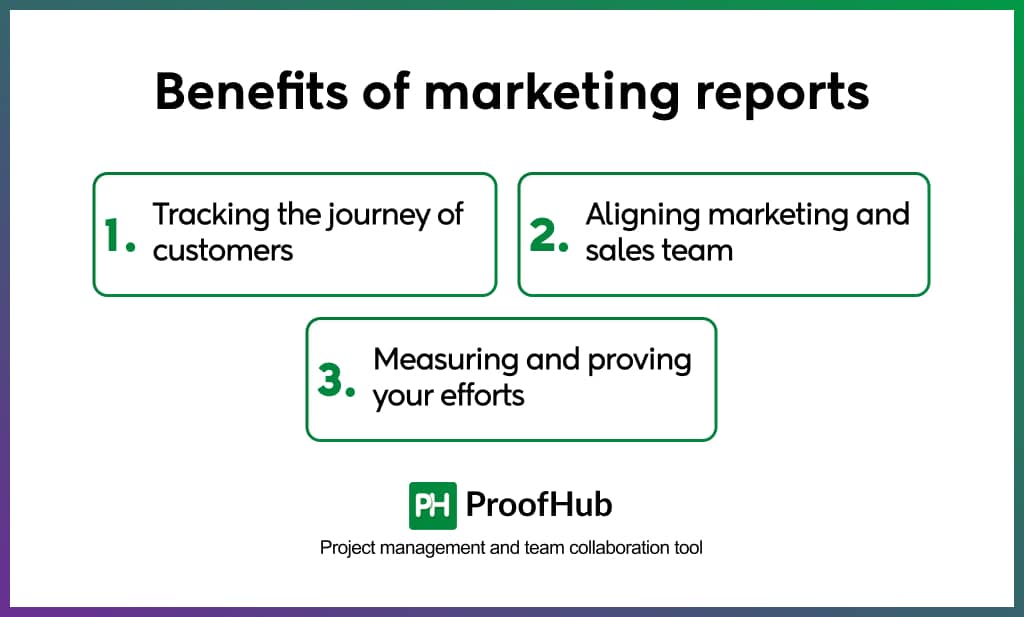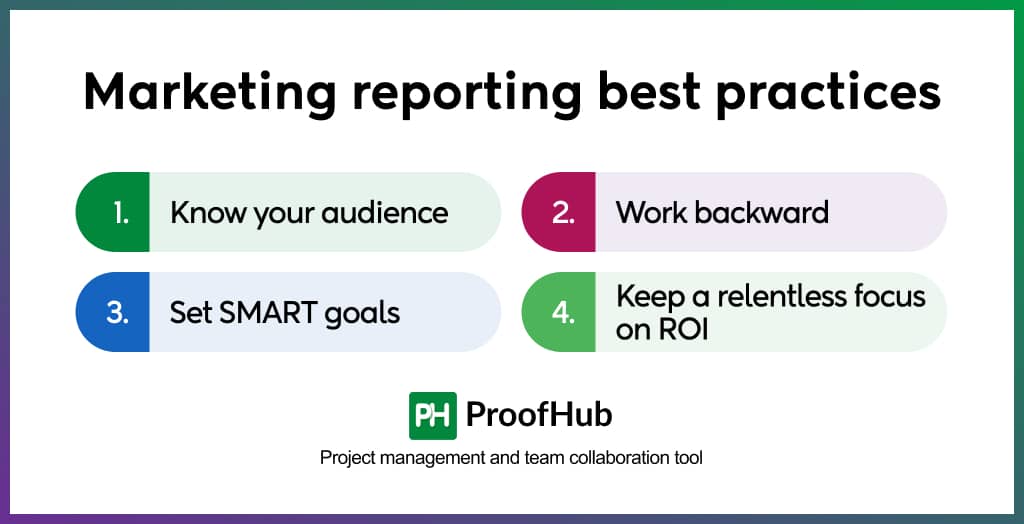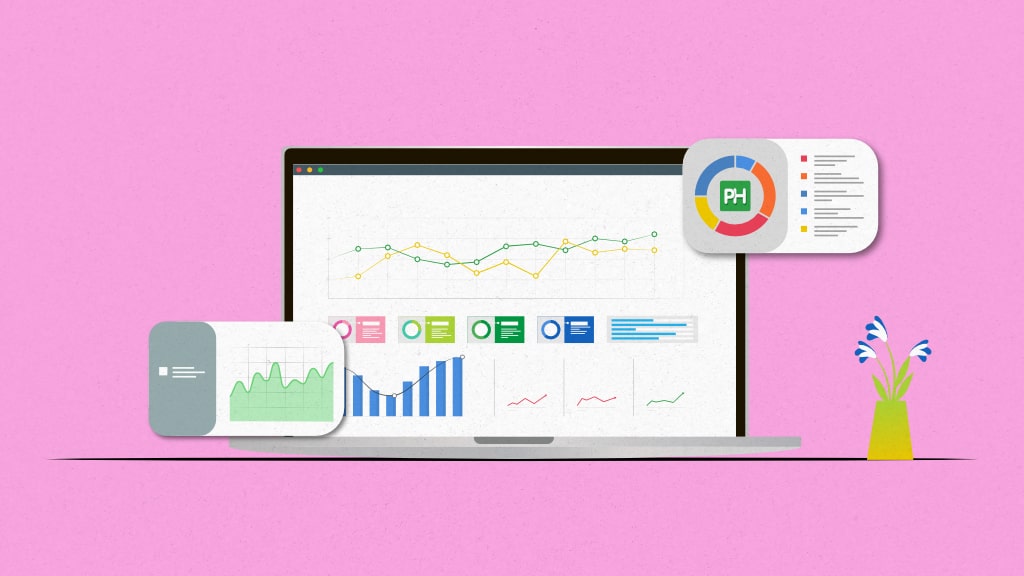Marketing reporting provides organizations with valuable insights into various marketing channels, campaigns, and initiatives, enabling businesses to track progress, identify opportunities, and mitigate challenges effectively.
Marketing reporting serves as a compass that helps businesses make informed and strategic decisions. It is a powerful tool for businesses seeking growth, drive innovation, and achieve sustainable success.
In this article, we will understand everything about marketing reporting, its types, and best practices for generating reports.
What is marketing reporting?
Marketing reports gather and analyze marketing metrics to notify future marketing decisions, strategies, and performance. Marketing reports reveal meaningful, actionable data that helps you draw essential conclusions and meet organizational goals. The reports vary depending on what information you are reviewing and the purpose of each report. They can determine where your traffic and leads are coming from, what content they interacted with when they converted, and how long it took them to become users.
In short, marketing reporting is a precious process if used and implemented correctly. In the next section, we’ll learn why marketing reporting matters.
Why is reporting important in marketing?
A marketing report will help you make a firm decision. According to research, 75% of teams use marketing reports for their campaigns. A marketing report is simple; however, it is how you will use the data to decide or draw a conclusion. Once you determine the goal of your marketing report, you’ll have a better idea of what reports to run and how to use said data.
Marketing reports are valuable because they can inform decisions made by various people across the organization. Whether you’re delivering a marketing report to the team lead, department manager, or CEO, your marketing report is tailored to whoever may be reading and using it.
Marketing reports can save you a lot of time. Here are some of the reasons that uphold why marketing reports matter. Whether you create a recurring reminder on your calendar or set your reports to run, schedule your marketing reports ahead of time automatically. Marketing reports will take the guesswork out of your reports and send them to the relevant audiences.
To succeed in a dynamic marketplace, companies need to know which campaigns are striking the right chord and which aren’t. Marketing reports are an effective way to get clarity on campaign performance.
Key benefits of marketing reports

1. Tracking the journey of customers
As a marketer, one thing you need the most is the prospective customers and when they will purchase your products and services. A marketing report gives you exactly that. Once you’ve all the details, you can offer your customers exactly what they want.
2. Aligning marketing and sales team
Did you know that the off-balance between sales and marketing departments costs businesses more than a trillion dollars annually? That’s like $1 trillion (yes, 12 zeros)!
Data must flow across the entire organization so the teams can do what’s needed to reach the goals. And this can be achieved with marketing reports. The marketing team can look into the marketing report, find things that are not going well with the target audience, make changes to their strategy, and bring sales on track.
3. Measuring and proving your efforts
Marketing reports show the worth of your efforts. It can display your campaigns, generate leads, bring revenue, and turn your prospects into customers. It will tell you what’s working, what isn’t, and what needs to be improved. Without marketing reports, companies are flying blind, and they’ll probably end up getting hit by something they didn’t see coming.
Types of marketing reports

For effective tracking of digital marketing activities, there are reports that you can run to dig into your marketing efforts. We’ve pulled together these five marketing reports examples for you to get started.
There are many marketing reports, and all come with a unique purpose. Breaking down the marketing activities into reports makes reviewing and taking an in-depth look at each strategy easier. Marketing reports refer to standard-set Key Performance Indicators to track progress within a period.
Marketing reports will generally have the following:
1. General Marketing Report
The general marketing report provides the big picture, showing an overview of all marketing activities. One of the main inclusions in a general marketing report is digital marketing ROI. General reports may also include the volume of leads, origin, the best-performing campaign or funnel, and the cost of each charge. It may also include information about conversion rates. The conversion rate measures how visitors perform a valuable action. It overviews all your marketing efforts – from content marketing to e-commerce analytics.
2. SEO Marketing Report
SEO (Search Engine Optimization) handles SEO performance reports. The report monitors organic and paid traffic, ranking positions and factors in the SERPs, overall keyword strategy, new blog posts created, backlink reports, and more. It aims to consider how well the business is doing, what is helping it, and what could be improved. This report keeps you, your team, and your clients in the loop as to how your SEO efforts are performing.
3. Email Marketing Reports
Email marketing reports enable you to monitor whether campaigns reach your audience and fulfill their engagement goals. Marketers will also use tools like Mailchimp to track campaigns automatically when going over email reports. The reports also include how many emails are landing in the recipient’s inbox, the open rate, and the reply rate.
4. Content Marketing Reports
These reports assess your digital content performance in terms of engagement and brand awareness and tend to track different channels, such as video, podcast, and blog performance. Some important metrics to track include how many people visit your page, how long they stay on the page, and how many likes, shares, and comments every post receives. This information is valuable as it allows marketing teams to understand what their audience likes and therefore create future content that is similar in style.
5. Campaign Reports
Stakeholders often want to see a report once the marketing campaign has ended. Perhaps your teams did a ThanksGiving campaign that consisted of the following:
- Newsletters to existing customers
- Advertisements on social media
- Display ads through the Google Display network
- Affiliate Marketing
You can find KPIs, goals runtime, and budget in this initial plan. Then, compare the plan with the results of the campaign.
How to create a marketing report
If you want to create a marketing report that your stakeholders, clients, and CEOs want to read, consider including the things below.
- Title
What is your marketing report analyzing? Whether you are running a report on campaign performance, quarterly blog performance, or monthly leads, make sure to title your report, so the intent is always clear. This becomes important when sharing your report with people outside of marketing.
- Reporting period
Your marketing report should reflect a certain time period. This period can be from a few days, months, or even years. Analyzing your data within a time period will allow you to compare performance to past periods.
- Summary
The report summary should reflect the key points of the report, including your accomplishments, losses, and goals for the next reporting period. It is the TL;DR (too long, didn’t read) of the report.
Marketing reporting best practices

Marketing reports can take up a lot of your time. Here are some best practices to help you work more smartly.
1. Know your audience
The first marketing report question that you need to ask yourself is, “Who is this report for?” A report that is just for you and your team will cover all the nuances rather than a report that you’ll be presenting to your executive team. It is for your purposes to assess their effectiveness and inform your future decisions.
How many times was your post shared on Twitter, or what your email open rates were like that might be considered important and differ from the business? This type of information will be too granular for executives who want to see the big picture.
2. Work backward
While assembling the report, it can be helpful to start with your company’s objectives and work backward to ensure you’re covering all the key metrics to show the value you’re contributing to the organization.
How many customers are required to meet the revenue target? How many MQLs need to be generated to reach that number of conversions? And so on ..
In this way, you can work through all the stages of the buyer’s journey – awareness, consideration, and decision, that will help you to show customers are moving through the journey. For example, a key metric that demonstrates awareness would be your monthly website traffic, which can be broken down to show you which marketing channels are most effective.
It is a good idea to narrow down the crucial KPIs and focus on them to tell a story and show how well you’re progressing.
3. Set SMART goals
So if you’ve decided which KPIs to measure your success, that’s fantastic – but it isn’t the end. Once you’ve got your data, the next step is to create SMART goals based on that data. What’s working? What isn’t working, and how can you build on that success?
For example, suppose your paid strategy isn’t quite generating web traffic. In that case, a goal might be to direct your budget from low-performing to high-performing keywords to get more visibility.
These goals should then be addressed in the following report – where were they achieved or not? This helps you track your progress and focus on your strategy.
4. Keep a relentless focus on ROI
According to a report, just over 75% of marketers report on how their campaigns directly influence revenue, but only 35% said that understanding the ROI of their campaigns was extremely important.
Not only does it prove marketing’s value to the organization, but it also serves as another metric to help you refine your strategy. For example, how much time are you spending on social media, only to find those efforts are not generating high-quality leads? In that case, you might want to redirect your efforts to those channels where you can focus on ROI.
Marketing reports examples
Marketing reports are designed with the most relevant KPIs and they are fully customizable so that you can change them according to your or your client’s requirements.
1. PPC Marketing Report
A pay-per-click marketing report is a detailed snapshot of all your paid advertising and promotion activities for platforms like Google, Instagram, Twitter, Linkedin, Facebook, and YouTube. A PPC marketing report will include stats on:
- Clicks and cost per click
- Ad performance by platform
- Conversion rates for all platforms
- Number of leads
- Revenues
2. Social Media Marketing Report
The two aspects of social media marketing are paid (Facebook Ads) and organic (content marketing). Among them, the most popular social networks are Facebook, Twitter, Instagram, YouTube, and LinkedIn. Key KPIs that should be in your report:
- Likes and followers
- Impressions and reach
- Demographics of the target audience
- Top performing posts
- Engagement
How will ProofHub help you as your marketing reporting software?
Marketing reports need to be crafted keeping a specific purpose in mind. Using dedicated marketing project management software like ProofHub helps marketers generate reports quickly. Teams can manage tasks, execute marketing strategies, communicate with team members and clients, and create deliverables on time.
With ProofHub, you can get your team to run daily functions smoothly and jumpstart projects effectively. You could also use request forms to track work requests and support queries.
You get to assign tasks, share essential details, prioritize tasks, and capture every aspect of the project in one place with the help of ProofHub’s table view.
With Gantt charts, teams can effectively plan projects and visualize the outcomes. Gantt charts are a great way to adjust to any new developments or changes in the project.
Kanban board users can divide their tasks into workflow stages, an excellent way for teams to self-manage projects.
Teams can communicate with each other and external partners with the help of ProofHub’s individual and group chat options. Lastly, the online proofing tool is a boon for all users as it saves time and eliminates errors of all sorts. With markup tools, users can give feedback for specific areas as well.
Take your marketing campaigns from inception to execution successfully with ProofHub. Start your free trial.
Conclusion
Misfortunes always come to those who are unaware of the changes occurring in marketing reporting. The key to staying abreast of the marketing niche is to know all about the marketing reports and this article does exactly that.
Marketing reporting is an important part of the marketing efforts and the growth of your business. Start with these marketing reporting examples today and expand your reporting as you begin to utilize more data.
FAQs
What do marketing reports provide?
A marketing report provides an analysis of all the data gathered from a particular marketing strategy or campaign and makes recommendations regarding potential future campaigns.
What are the tools used in reporting?
Marketers save their time by using marketing reports like Google Analytics, Campaign Monitor, DashThis, Klipfolio Inc, Zoho Corporation, among others.
What metrics should be included in a marketing report?
Marketing metrics like traffic and engagement rates, sales, expenditures, and revenue should be included in a marketing report.

